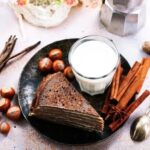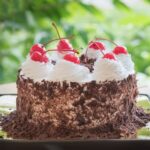Are you looking to add a touch of rustic elegance to your next special occasion? Learn how to decorate naked cake for a stunning dessert option that’s both beautiful and delicious.
The naked cake trend has taken the baking world by storm, offering a unique and charming alternative to traditional frosted cakes. In this article, we’ll explore the history and origin of the naked cake trend, as well as why these delectable treats have become a popular choice for weddings, birthdays, and other celebrations.
Naked cakes are characterized by their exposed layers of cake, typically with minimal frosting or none at all on the outside. This pared-down approach allows the natural flavors and textures of the cake to shine through, making it an ideal choice for those who prefer a less sweet dessert option. Originating from humble beginnings but now gracing the tables of elegant events, naked cakes offer a versatile canvas for creativity in both flavor and decoration.
Whether you’re an experienced baker or just starting out in the world of cake decorating, understanding the ins and outs of creating the perfect naked cake is essential. From choosing the right cake base to selecting fillings and frostings that complement its rustic charm, we’ll cover all you need to know to create a show-stopping masterpiece that will have your guests’ mouths watering.
So let’s dive into what makes naked cakes so special and how you can master the art of decorating them for any occasion.
Choosing the Right Cake Base
When it comes to creating a stunning naked cake, the foundation is key. The right cake base can make all the difference in achieving the perfect texture and flavor for your creation. Here are some tips for choosing the right cake base:
- Best cake flavors and textures for naked cakes: Opt for moist and dense cake flavors that can hold up well without traditional frosting. Classic choices include vanilla, chocolate, and red velvet, but feel free to get creative with unique flavors like lemon, carrot, or almond.
- Tips for baking the perfect naked cake layers: To ensure even layers that are sturdy enough for stacking, use high-quality ingredients and take care not to over-mix the batter. Bake the layers until they are just set and allow them to cool completely before assembling your naked cake.
Whether you prefer a classic flavor or something more experimental, the right cake base will provide a solid starting point for your naked cake masterpiece. With a good foundation in place, you’ll be well on your way to creating a beautiful and delicious dessert that will impress any crowd.
For those looking to add their own personal touch to their naked cakes, experimenting with different flavors and textures can lead to unique and exciting results. Don’t be afraid to think outside of the box when choosing your cake base and have fun exploring different options to find the perfect fit for your next naked cake creation.
Filling and Frosting Options
When it comes to decorating a naked cake, the filling and frosting options play a crucial role in achieving the perfect look and taste. The beauty of a naked cake lies in its minimalistic approach to frosting, allowing the layers and fillings to be the star of the show. There are various filling and frosting options that can complement naked cakes, adding both flavor and visual appeal to your creation.
Different Types of Fillings and Frostings
For naked cakes, it’s important to choose fillings and frostings that are not too heavy or overpowering, as they should enhance the natural flavor of the cake. Popular fillings for naked cakes include fruit preserves, curds, compotes, and lightly whipped cream.
These fillings add a burst of flavor without overwhelming the delicate cake layers. As for frostings, a light coat of Swiss meringue buttercream or cream cheese frosting works well for achieving the naked look while providing a touch of sweetness.
Achieving the Naked Look
One key aspect of decorating a naked cake is to achieve the desired “barely there” look without over-frosting the cake. To achieve this, it’s important to use a light hand when applying the filling and frosting.
The goal is to showcase the layers and create a rustic and unfinished appearance. Many decorators opt for using an offset spatula or palette knife to spread thin layers of filling and frosting onto each cake layer, allowing some of the cake to peek through for that quintessential naked look.
Embracing Creativity
While traditional flavors like vanilla or chocolate are popular choices for naked cakes, don’t be afraid to get creative with your filling and frosting combinations. Experiment with different fruit flavors, flavored syrups, or even floral-infused fillings for a unique twist on classic naked cakes. Remember that part of the fun in decorating naked cakes is showcasing your creativity through flavors and presentation while maintaining the essence of simplicity that sets this trend apart.
Layering and Stacking Techniques
When it comes to creating a visually stunning naked cake, the layering and stacking techniques are crucial in achieving the desired rustic and natural look. To start, it is important to ensure that your cake layers are baked and cooled properly before beginning the assembly process. The key to a successful naked cake is to have even, flat layers that will stack securely without slipping or collapsing.
To achieve this, it’s essential to invest in quality cake pans for baking your layers. Non-stick pans with straight edges are ideal for creating smooth, uniform layers. Once the cake layers are baked and cooled, it’s time to level them using a serrated knife or a cake leveler. This step ensures that each layer is uniform in height, allowing for a balanced and stable stacked cake.
When stacking the layers, it’s important to use a sturdy base such as a cake board or plate. Start by placing a dollop of frosting on the base to secure the first layer in place. Then, add an even layer of filling on top of the first cake layer before carefully placing the second layer on top. Repeat this process for additional layers, ensuring that each layer is centered and level as you stack.
Finally, once all the layers are stacked, gently press down on the top of the cake to ensure stability and evenness. If using multiple tiers, consider adding dowels or support straws between tiers for added stability. With these techniques, you can achieve a beautiful and stable naked cake ready for decorating.
| Layering Tips | Stacking Techniques |
|---|---|
| Invest in quality cake pans | Use sturdy base such as cake board |
| Level cakes with serrated knife or cake leveler | Add dowels or support straws for multi-tiered cakes |
| Secure each layer with dollop of frosting | Gently press down on top of completed stacked cake |
Decorative Elements for Naked Cakes
When it comes to decorating naked cakes, the options for adding decorative elements are endless. Whether you’re aiming for a rustic, bohemian look or a more elegant and refined design, there are several decorative elements that can elevate the appearance of your naked cake.
Fresh Fruit Arrangements
One popular way to adorn naked cakes is with fresh fruit arrangements. Berries, such as strawberries, blueberries, and raspberries, can be strategically placed on top of the cake or in between the layers to add a burst of color and a touch of natural sweetness. Slices of kiwi, peach, or mango can also be used to create visually appealing patterns or designs.
Edible Flower Decorations
For a whimsical and romantic touch, consider using edible flowers to decorate your naked cake. Delicate blooms like roses, lavender, and pansies not only add a pop of color but also bring a fragrant aroma to your creation. It’s important to ensure that any flowers used for decorating are indeed edible and have not been treated with chemicals.
Sprinkle and Drizzle Techniques
If you’re looking for a fun and playful way to decorate your naked cake, sprinkle and drizzle techniques can add an element of whimsy. Colorful sprinkles or edible glitter can be lightly sprinkled over the top layer of the cake for a festive look. Alternatively, a drizzle of caramel or chocolate sauce can be artfully applied over the edges of the cake for an eye-catching finish.
By incorporating these decorative elements into your naked cake design, you can transform a simple dessert into an exquisite work of art that will impress both visually and gastronomically.
Tools and Techniques for Decorating Naked Cakes
Decorating a naked cake requires the right tools and techniques to achieve the desired look. Here are some essential items and methods to consider when decorating your naked cake:
- Offset spatula: This tool is essential for spreading fillings and frostings evenly between cake layers, as well as creating a smooth finish on the outside of the cake.
- Cake comb: A cake comb is a handy tool for creating a rustic texture on the sides of a naked cake. It can be used to create different patterns or designs, adding visual interest to the finished product.
- Piping bag and tips: If you want to add decorative details or borders to your naked cake, a piping bag and various tips can help you achieve precise designs with icing or whipped cream.
When it comes to techniques for decorating naked cakes, there are several methods that can help you achieve a stunning result:
- Icing in between layers: To achieve an even distribution of filling between cake layers, use an offset spatula to spread the filling smoothly without causing the layers to shift.
- Smooth frosting on the outside: Use an offset spatula to gently spread a thin layer of frosting on the outside of the cake, ensuring that it does not cover the entire surface but still provides a cohesive look.
- Add decorative elements: Once the base frosting is applied, use fresh fruit, edible flowers, or sprinkles to add visual interest and color to your naked cake. These decorative elements can enhance the overall presentation of your creation.
By using these tools and techniques effectively, you can create a beautifully decorated naked cake that will impress your guests at any special occasion.
Troubleshooting Common Naked Cake Decorating Issues
Decorating a naked cake can be a fun and creative process, but it doesn’t come without its challenges. One common issue that decorators face is uneven frosting. This can happen when the layers of the cake are not level, or when the frosting is applied too thinly in some areas and too thickly in others.
To fix this problem, start by using a serrated knife to carefully trim any uneven parts of the cake layers. Once the layers are level, you can then apply a thin crumb coat of frosting to seal in any loose crumbs before adding the final layer of frosting.
Another common problem when decorating naked cakes is preventing the cake layers from drying out during the decorating process. Since naked cakes have minimal frosting on their exterior, there is a risk of the cake becoming dry if left exposed for too long.
To prevent this, it’s important to work quickly and efficiently when applying fillings and frostings to each layer. Additionally, you can use simple syrup to moisten the cake layers before adding fillings or frostings, ensuring that your naked cake stays moist and delicious.
In order to create a beautifully decorated naked cake, it’s essential to troubleshoot these common issues and find effective solutions. By addressing uneven frosting and preventing dry cake layers, you can ensure that your naked cake not only looks stunning but also tastes as good as it looks. With these troubleshooting tips in mind, you’ll be better equipped to tackle any challenges that may arise during the decorating process and create a masterpiece that will impress your guests.
Final Tips for Success
Transporting and storing naked cakes can be a bit tricky, especially with the exposed layers and delicate decorations. To ensure your beautifully decorated naked cake remains intact during transport, it’s best to assemble it on-site if possible. If you need to transport the cake already assembled, make sure to refrigerate it first to firm up the frosting and then carefully place it in a cake carrier or box with proper support to prevent any movement.
When it comes to personalizing naked cakes for different occasions, the possibilities are endless. For a rustic wedding, consider adorning the cake with fresh berries and greenery for an organic and elegant look. For a summer birthday celebration, incorporating vibrant edible flowers can add a pop of color and whimsy to the cake. Get creative with your decorative elements to really make the naked cake stand out for any event.
As a final tip for success, don’t forget to capture the beauty of your finished masterpiece by taking stunning photographs. A well-lit setting with natural light is ideal for capturing the details of the naked cake.
Experiment with different angles and compositions to showcase all the decorative elements and textures of your creation. Once you’re satisfied with your photos, don’t hesitate to share your gorgeous naked cake on social media platforms – not only will you inspire others, but you may also receive valuable feedback and encouragement from fellow baking enthusiasts.
Conclusion
In conclusion, the naked cake trend has become a popular choice for special occasions due to its rustic yet elegant appeal. By understanding the different aspects of decorating a naked cake, such as choosing the right cake base, filling and frosting options, layering and stacking techniques, decorative elements, and tools and techniques for decorating, anyone can create a stunning masterpiece.
It’s important to remember that the beauty of a naked cake lies in its simplicity, so it’s essential to not over-frost the cake and to use decorative elements such as fresh fruit arrangements, edible flowers, or sprinkle and drizzle techniques effectively.
When it comes to showcasing your beautifully decorated naked cake, presentation is key. Taking high-quality photos of your creation will not only allow you to capture its beauty but also serve as inspiration for future projects.
Whether you’re baking for personal enjoyment or for a special event, sharing your creations on social media can also provide encouragement and feedback from others who share your passion for baking and decorating. Additionally, consider personalizing your naked cakes for different occasions to make each one unique and memorable.
In the end, decorating naked cakes is not just about following a trend – it’s an opportunity to unleash your creativity and express yourself through delicious works of art. As you continue on your journey of creating stunning naked cakes, remember to have fun with the process and don’t be afraid to experiment with different flavors, fillings, and decorations.
With practice and passion, you’ll be able to consistently produce beautifully decorated naked cakes that will leave a lasting impression on all who indulge in them.
Frequently Asked Questions
What Is the Trend in Unfrosted Cake?
The trend in unfrosted cake is gaining popularity due to the rise of minimalist and natural aesthetics. Unfrosted cakes provide a more rustic and simple look that appeals to those who prefer a less sweet and heavy dessert option.
Many bakers are also experimenting with various decorative elements like fresh fruit, edible flowers, or powdered sugar to enhance the visual appeal of unfrosted cakes.
How Do You Make a Plain Cake Look Better?
There are several ways to make a plain cake look better without frosting. One option is to use a simple glaze made from powdered sugar and milk, which can add a glossy finish and hint of sweetness to the cake.
Another approach is to top the cake with fresh berries, sliced fruits, or toasted nuts for added texture and color contrast. Dusting the cake with cocoa powder or confectioners’ sugar can also create an elegant and understated look.
What Can I Put on a Cake Instead of Frosting?
Instead of frosting, there are many alternatives that can be used to decorate a cake. Whipped cream, either sweetened or flavored with extracts, can be spread on top of the cake for a lighter and less sugary option.
A drizzle of caramel or chocolate ganache can also add richness and flavor without the heaviness of traditional frosting. Additionally, using mascarpone cheese or cream cheese as a topping can give the cake a creamy and tangy element without being too sweet.

Welcome to my blog about home and family. This blog is a place where I will share my thoughts, ideas, and experiences related to these important topics. I am a stay-at-home mom with two young children. I hope you enjoy reading it! and may find some helpful tips and ideas that will make your home and family life even better!





